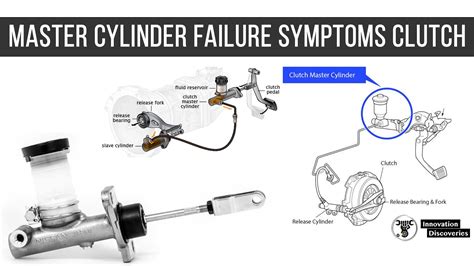Bad Clutch Master Cylinder Symptoms & How to Test
The clutch master cylinder, a crucial component of your vehicle's clutch system, plays a vital role in transmitting hydraulic pressure to the slave cylinder, enabling you to smoothly engage and disengage your clutch. When this vital part starts failing, it can lead to frustrating and potentially dangerous driving experiences. Recognizing the symptoms of a failing clutch master cylinder is crucial for preventing more significant damage and ensuring your safety on the road. This article will delve into the common symptoms of a bad clutch master cylinder and guide you through testing procedures to confirm whether it's the culprit behind your car trouble.
Common Symptoms of a Failing Clutch Master Cylinder
Several telltale signs indicate that your clutch master cylinder might be on its way out. These symptoms often manifest gradually, giving you some warning before a complete failure. However, it's crucial to address them promptly to prevent more serious and costly repairs.
-
Hard or Stiff Clutch Pedal: One of the most common symptoms is a noticeably harder-than-usual clutch pedal. This increased resistance is due to the reduced hydraulic assistance from a failing master cylinder. It may feel spongy or require significantly more force to depress.
-
Clutch Pedal Goes to the Floor: In more severe cases, the clutch pedal may sink all the way to the floor with minimal or no resistance. This indicates a complete loss of hydraulic pressure within the system, rendering the clutch unusable.
-
Clutch Pedal Feels Spongy: A spongy clutch pedal is another key indicator. This often points to air in the hydraulic lines or internal leaks within the master cylinder itself, compromising the pressure build-up needed for proper clutch operation.
-
Clutch Slipping: While not always directly caused by a failing master cylinder, clutch slippage can sometimes be a secondary symptom. If the master cylinder isn't providing sufficient pressure, the clutch may not fully engage, resulting in slippage.
-
Clutch Engagement Problems: You may experience difficulty engaging the clutch at the usual bite point. This could be due to inconsistent hydraulic pressure caused by the failing master cylinder.
-
Fluid Leaks: Look for fluid leaks around the clutch master cylinder. Hydraulic fluid is typically a dark brownish color. Any visible leaks are a strong indication of internal damage or seal failure within the master cylinder.
How to Test Your Clutch Master Cylinder
Before you dive into replacing your clutch master cylinder, it's essential to confirm that it is indeed the source of the problem. Here's a step-by-step approach to test your clutch master cylinder:
1. Visual Inspection
Begin by carefully inspecting the clutch master cylinder for any signs of leaks. Check the surrounding area for any fluid accumulation. Look closely at the cylinder itself for cracks, corrosion, or damage.
2. Checking Fluid Level
Locate the clutch master cylinder reservoir (usually a small container near the master cylinder). Check the fluid level. Low fluid levels could indicate a leak within the system. Remember, topping off the fluid only temporarily masks the problem; a leak must be addressed.
3. Bleeding the Clutch System
Air in the hydraulic lines can mimic the symptoms of a bad master cylinder. Bleed the clutch system to eliminate air. This procedure is usually straightforward and can be found in your vehicle's repair manual or through numerous online resources. If bleeding the system doesn't resolve the issue, the master cylinder itself is likely faulty.
4. Pressure Test (Advanced):
This method requires special tools. A pressure gauge can be connected to the clutch system to measure the hydraulic pressure. If the pressure is significantly low or inconsistent, it suggests a problem with the master cylinder. This is best left to a mechanic with the necessary equipment.
What if it’s not the Master Cylinder?
It's important to note that other components can also cause similar symptoms. A problem with the slave cylinder, clutch cable (if applicable), clutch disc, pressure plate, or throw-out bearing can also lead to issues with the clutch. A thorough diagnostic is essential to pinpoint the exact source of the trouble.
Frequently Asked Questions
How much does it cost to replace a clutch master cylinder?
The cost varies greatly depending on the vehicle, labor costs, and the price of the replacement part. Expect to pay anywhere from a couple hundred to several hundred dollars for the repair.
How long does it take to replace a clutch master cylinder?
The replacement process typically takes a few hours for experienced mechanics. However, this can vary depending on vehicle complexity and access to the master cylinder.
Can I drive with a bad clutch master cylinder?
While you might be able to drive for a short distance, driving with a bad master cylinder is highly discouraged. You risk complete clutch failure, leading to dangerous situations, especially while shifting gears.
This detailed guide offers a comprehensive understanding of bad clutch master cylinder symptoms and effective testing methods. Remember to prioritize safety and seek professional assistance if you're unsure about performing these tests yourself. Early detection and timely repair can save you time, money, and potential accidents.

